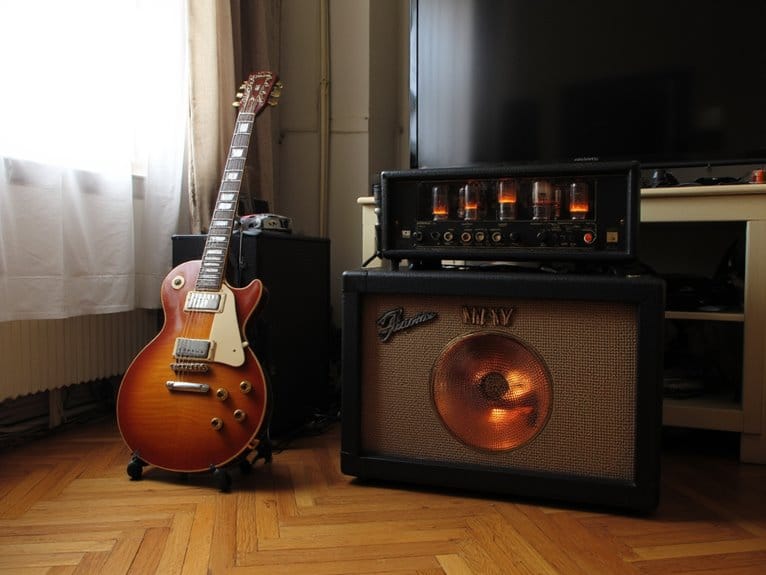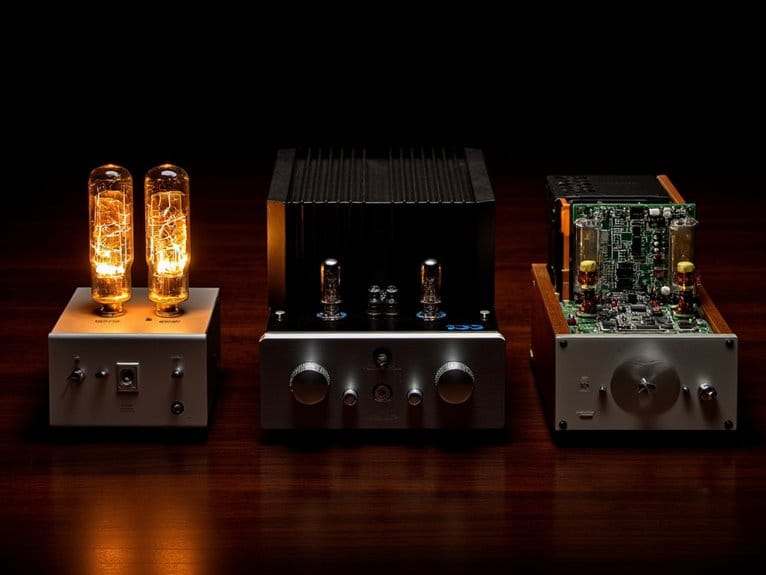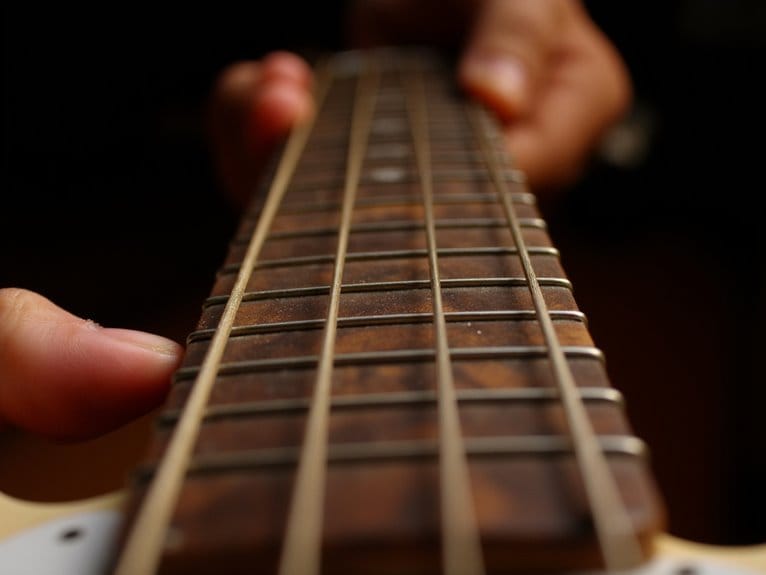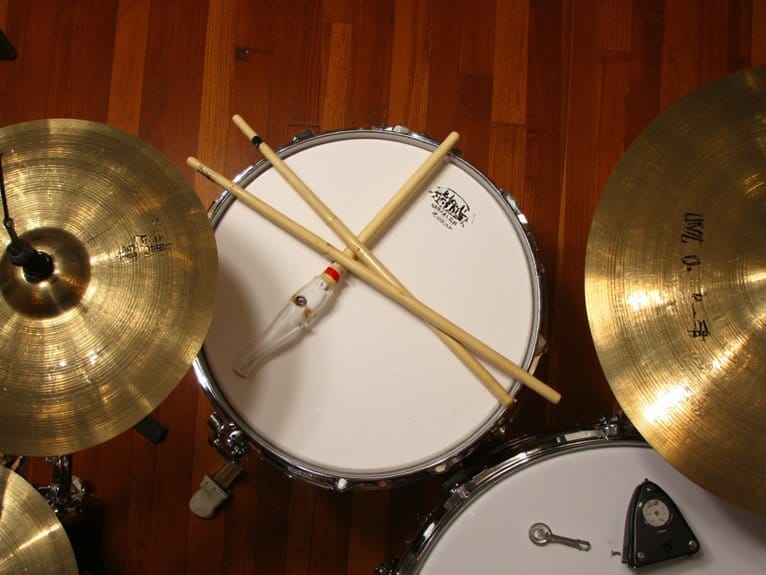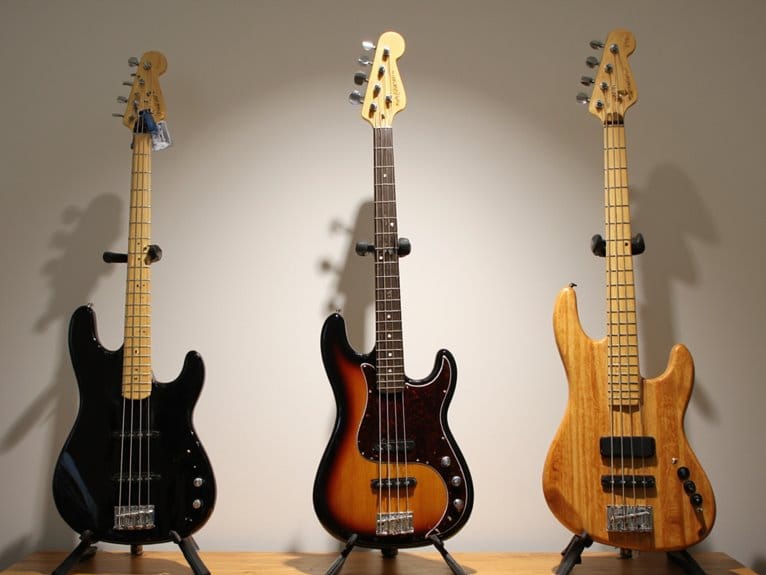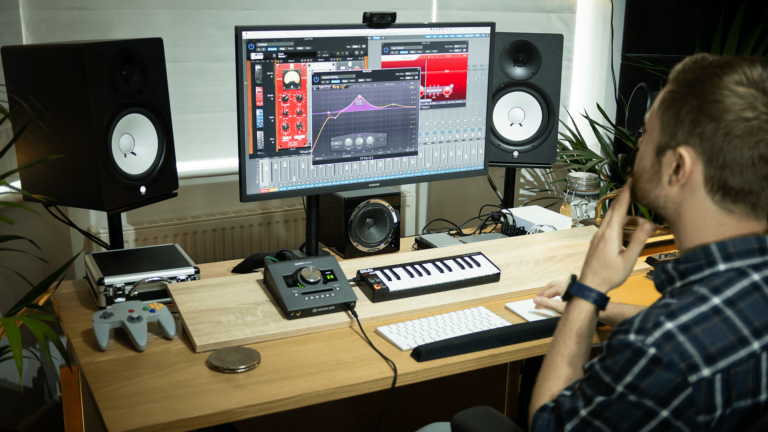Getting Great Tube Guitar Tone at Apartment-Friendly Volumes
You’ll want a 1-15 watt tube amp with EL84 tubes that break up naturally at lower volumes, like the Vox AC15C1 or Bugera V5 Infinium. Use your master volume to push preamp gain while keeping output low, boost midrange frequencies, and consider a reactive attenuator for additional volume control. Smaller 8-inch speakers provide focused midrange perfect for apartments, while direct recording through an audio interface lets you capture that tube warmth without disturbing neighbors—there’s much more to explore about optimizing your setup.
We are supported by our audience. When you purchase through links on our site, we may earn an affiliate commission, at no extra cost for you. Learn more.
Notable Insights
- Choose 1-15 watt tube amps with EL84 tubes that break up early for natural overdrive at low volumes.
- Use master volume controls to push preamp gain while keeping overall output low for warm, saturated tone.
- Install reactive attenuators like the Universal Audio OX to achieve cranked amp tone without excessive volume.
- Select smaller 8-inch speakers in quality cabinets for focused midrange response ideal for apartment practice.
- Record direct through audio interfaces with headphone monitoring to capture tube characteristics at minimal volumes.
Choosing the Right Low-Wattage Tube Amp for Small Spaces
When you’re living in an apartment or small space, finding that sweet tube amp tone without angering your neighbors becomes a delicate balancing act that I’ve personally navigated for years.
Your best bet lies in the 1-15 watt range, where amps like the Vox AC15C1 or Bugera V5 Infinium deliver authentic tube saturation at manageable volumes.
Low-wattage tube amps in the 1-15 watt sweet spot give you that coveted tube breakup without the volume headaches.
I’ve found that amp size considerations extend beyond just wattage—speaker efficiency and tube complement matter considerably. EL84 tubes break up earlier than their higher-powered cousins, giving you natural overdrive without excessive volume. Modern amplifiers with Adaptive AutoBias technology can automatically monitor your tubes and reduce distortion by over 50% while extending tube life.
Look for tone shaping techniques like built-in attenuators, headphone outputs, and multiple EQ controls, which let you craft your sound without cranking the master volume and earning those dreaded neighbor complaints. Built-in effects can expand your sound options significantly, allowing you to achieve complex tones without additional pedals or external processing gear. While tube amplifiers require periodic tube replacement, their warm harmonic distortion and touch sensitivity make them the preferred choice for discerning players seeking authentic tone. Closed-back designs improve sound projection without raising volume, making them particularly suitable for apartment practice sessions.
Dialing In Your Amp Settings for Maximum Tone at Low Volume
Now that you’ve chosen your low-wattage tube amp, the real challenge becomes coaxing maximum tonal richness from those glowing bottles without cranking the volume past apartment-friendly levels—a puzzle I’ve spent countless late nights solving through trial and error.
Your master volume becomes your secret weapon here, allowing you to push preamp gain for natural tube saturation while keeping overall output whisper-quiet. I’ve found that moderate gain with low master volume produces warmer, clearer tones than maxing either control alone.
Essential EQ adjustments include boosting midrange to combat the scooped, thin sound that plagues low-volume playing, while slightly reducing treble and raising bass compensates for diminished speaker response at quiet levels.
Consider recording your tube amp through a quality audio interface, as many modern units feature zero-latency monitoring capabilities that allow you to hear your true amp tone through headphones without any delay, perfect for late-night practice sessions. Budget options under $200 now offer professional-grade preamps that capture your tube amp’s warmth and character with surprising accuracy.
Using Attenuators and Pedals to Tame Your Sound
While careful amp dialing gets you surprisingly far in the volume battle, I’ve discovered that sometimes you need heavier artillery—attenuators and strategic pedal placement can release those sweet spot tones that normally require ear-splitting volumes.
Understanding attenuator types becomes vital here, as reactive models like the Two Notes Torpedo Captor X preserve your amp’s character through impedance simulation, while basic resistive units often muddy your carefully crafted tone.
I’ve found that pedal integration works best when you place overdrive and EQ pedals before your amp’s input, allowing you to compensate for the compressed dynamics that attenuators sometimes introduce. Like wind instruments that require proper maintenance for optimal sound quality, guitar amplifiers benefit from regular maintenance to preserve their tonal characteristics and responsiveness over time.
Advanced units like the Universal Audio OX offer speaker modeling and DI outputs, fundamentally giving you studio-quality recording capabilities at whisper volumes.
For bassists facing similar volume constraints, preamp pedals with built-in DI outputs can provide direct connections to recording interfaces while maintaining professional tone quality at any volume level.
Speaker Cabinet Selection and Room Placement Strategies
After dialing in your amp and taming its volume, I’ve learned that your speaker cabinet choice becomes the foundation that either elevates or undermines everything you’ve accomplished so far.
Cabinet size and speaker diameter dramatically affect tonal coloration—smaller 8-inch speakers deliver tighter midrange focus, while 12-inch drivers provide fuller bass response that can overwhelm apartment acoustics.
Speaker size shapes your sound—8-inch drivers tighten midrange punch while 12-inch speakers deliver deep bass that easily overwhelms small spaces.
Open back cabinets interact more with room reflections, creating diffuse sound dispersion, whereas closed back cabinets offer controlled, direct projection that’s easier to manage in confined spaces.
Wood type influences resonance quality; Baltic birch maintains clarity better than particle board alternatives.
Speaker magnet types and cone material affect efficiency at low volumes, while strategic placement strategies, like isolating your cabinet from floors and angling it toward yourself, optimize tone without disturbing neighbors. Impedance matching between your amplifier and cabinet ensures optimal power transfer and prevents damage to your equipment.
Many amplifiers include power attenuation systems that allow you to achieve cranked-tube sounds at manageable volumes, making them particularly valuable for apartment players who still want authentic tube saturation.
Recording Techniques and Practice Methods for Quiet Playing
Since even the most carefully chosen speaker cabinet and room placement can’t eliminate volume concerns entirely, I’ve discovered that mastering quiet playing techniques becomes essential for maintaining your practice routine without sacrificing tone quality.
Recording techniques using direct input methods capture authentic tube amp characteristics while keeping volume minimal, and I’ve found that combining this approach with amp simulators provides exceptional tonal flexibility.
For acoustic players, soundhole dampeners offer immediate volume reduction, though they’ll slightly alter your tone character. Developing dynamic control through gentle fingerpicking creates natural volume management, while silent guitars eliminate acoustic output entirely.
These practice methods, particularly when paired with headphone monitoring, allow you to maintain consistent playing schedules regardless of time constraints or neighbor considerations.
Small guitar amps in the 5-20 watt range can also provide excellent tube-like tone characteristics while maintaining apartment-friendly volume levels for practice sessions.
On a final note
You’ve now got the tools to achieve that warm, saturated tube tone without angering your neighbors or compromising your sound quality. Whether you’re using a low-wattage amp, an attenuator, or strategic speaker placement, the key is experimenting with different combinations until you find what works best for your space and style. Remember, great tone isn’t about volume—it’s about finding the sweet spot where your amp sings at any level.

